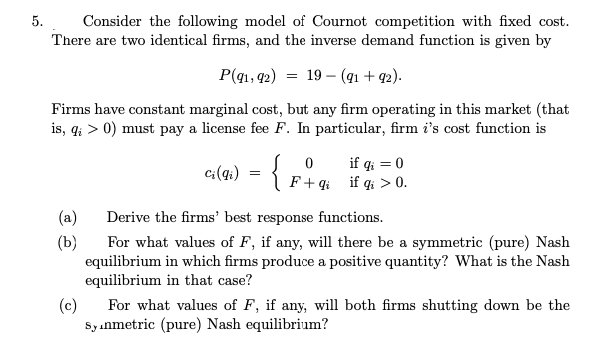There are two identical firms, and the inverse demand function is given by P(q1, 42) 19 – (41 + 92). Firms have constant marginal cost, but any firm operating in this market (that s, q; > 0) must pay a license fee F. In particular, firm i's cost function is a(m) = { if qi = 0 F+ qi if qi > 0. (a) Derive the firms' best response functions. (b) For what values of F, if any, will there be a symmetric (pure) Nash equilibrium in which firms produce a positive quantity? What is the Nash equilibrium in that case? (c) For what values of F, if any, will both firms shutting down be the Sy anmetric (pure) Nash equilibrium?
There are two identical firms, and the inverse demand function is given by P(q1, 42) 19 – (41 + 92). Firms have constant marginal cost, but any firm operating in this market (that s, q; > 0) must pay a license fee F. In particular, firm i's cost function is a(m) = { if qi = 0 F+ qi if qi > 0. (a) Derive the firms' best response functions. (b) For what values of F, if any, will there be a symmetric (pure) Nash equilibrium in which firms produce a positive quantity? What is the Nash equilibrium in that case? (c) For what values of F, if any, will both firms shutting down be the Sy anmetric (pure) Nash equilibrium?
Chapter15: Imperfect Competition
Section: Chapter Questions
Problem 15.4P
Related questions
Question

Transcribed Image Text:Consider the following model of Cournot competition with fixed cost.
There are two identical firms, and the inverse demand function is given by
5.
P(q1, 42)
19 – (q1 + 92).
Firms have constant marginal cost, but any firm operating in this market (that
is, q; > 0) must pay a license fee F. In particular, firm i's cost function is
if qi = 0
c:(4;) = { F+4 if qi > 0.
(a)
Derive the firms' best response functions.
(b)
For what values of F, if any, will there be a symmetric (pure) Nash
equilibrium in which firms produce a positive quantity? What is the Nash
equilibrium in that case?
(c)
For what values of F, if any, will both firms shutting down be the
Sy anmetric (pure) Nash equilibrium?
Expert Solution
This question has been solved!
Explore an expertly crafted, step-by-step solution for a thorough understanding of key concepts.
Step by step
Solved in 2 steps with 2 images

Knowledge Booster
Learn more about
Need a deep-dive on the concept behind this application? Look no further. Learn more about this topic, economics and related others by exploring similar questions and additional content below.Recommended textbooks for you


Managerial Economics: Applications, Strategies an…
Economics
ISBN:
9781305506381
Author:
James R. McGuigan, R. Charles Moyer, Frederick H.deB. Harris
Publisher:
Cengage Learning


Managerial Economics: Applications, Strategies an…
Economics
ISBN:
9781305506381
Author:
James R. McGuigan, R. Charles Moyer, Frederick H.deB. Harris
Publisher:
Cengage Learning